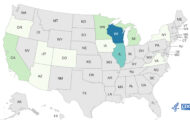The French caused a stir last year when they proposed a ban on BPA (Bisphenol-A) in their food packaging. The law will take effect on January 1, 2014. This change is going to have quite an effect on food manufacturers who export their product to France.
 If you haven’t yet heard about BPA, you will. This chemical is used to make plastics found in products such as baby and water bottles because it makes them shatterproof. It also is used for can linings, since foods, especially acidic foods, must be shielded from metal.
If you haven’t yet heard about BPA, you will. This chemical is used to make plastics found in products such as baby and water bottles because it makes them shatterproof. It also is used for can linings, since foods, especially acidic foods, must be shielded from metal.
The compound is controversial because it’s an endocrine disruptor. That means it mimics your body’s hormones. Some studies have found BPA causes weight gain, insulin resistance, excessive breast development, and prostate cancer in rodents.
The pros and cons of BPA follow the predictable trajectory of most controversial subjects. Some studies show problems; others suggest the chemical is harmless. But there does seem to be consensus on one topic: infants and children should be shielded from this compound.
Study History
Many studies have been conducted on BPA and its effects on health. Research is done on rodents and primates since their biological makeup resembles that of human beings. These are some of the more than 200 studies that have demonstrated potential problems with BPA:
- In 2007, the National Institutes of Health said they had “some concern” about BPA’s effects on fetal and early childhood development, because infants have the highest daily intake of the chemical.
- In 2008, a Yale Medical School study found that primates exposed to the maximum safe daily dose had “adverse neurological effects”, and discovered a connection between BPA intake and problems with memory and learning.
- A link was found between BPA and reduction of free testosterone levels in men in a study published in the Journal of Andrology in 2011.
- A 2010 study at Washington State University at the Center for Reproductive Biology found that the ovaries of mouse fetuses were affected by BPA.
- A 2011 study published in the journal Pediatrics found that BPA exposure in the womb leads to behavior problems in female toddlers.
- A study by the Peninsula College of Medicine and Dentistry found that BPA consumption is linked to heart disease.
More than 30 experts released a statement in 2007 stating that the average levels of BPA in human beings are above the levels that cause harm to laboratory animals. Exposure to this chemical is continuous, since it’s found in food, the air, and water. And no studies have been conducted on continuous BPA exposure.
On the other hand, the UK’s Food Standards Agency (FSA) released a statement in 2011 commenting on a 2007 Total Diet Study (TDS) of BPA exposure, saying that dietary exposure of adults to BPA shows the chemical is “rapidly absorbed, detoxified, and eliminated from humans – therefore is not a health concern.” The FSA concluded that levels of phthalates found in samples from the study “did not indicate a risk to human health from dietary exposure alone.”
In 2010, the U.S. government’s Health and Human Services agency and the FDA said that BPA “is not proven to harm children or adults.” The FDA said they would continue to “conduct additional scientific research to … clarify uncertainties” and said there was “some concern” about the chemical.
Government Response
Government responses to these studies have varied. In 2008, Canada decided to ban polycarbonate baby bottles containing BPA, since studies about infants and the safety of BPA are most compelling.
In 2010, the EU also banned marketing of polycarbonate baby bottles with BPA. That same year, Denmark placed a temporary ban on BPA in baby bottles. France followed suit, banning the chemical in products used by children under the age of three, and will ban it completely in food containers in 2014.
Japan took an interesting and proactive approach. By 2003, the canning industry in that country replaced BPA expoxies with another liner, and school lunch rooms started using BPA-free plastics. As a result, the blood levels of BPA in Japanese consumers has dramatically declined.
China has added BPA to its list of toxic substances.
Reaction in the United States has been varied and complicated. While the FDA has expressed “some concern”, and the EPA said in 2010 that BPA is a “chemical of concern”, there is no ban on the product in food containers.
In 2010, the FDA stated they want “a more robust regulatory framework for the oversight of BPA”. And as the result of a lawsuit filed by the National Resources Defense Council (NRDC), the FDA decided to not ban it but continue further studies.
Some states and cities, including Minnesota, Connecticut, and Chicago, have banned BPA in children’s products.
In one interesting twist, a ban on BPA was proposed as an amendment to the Food Safety Modernization Act in 2010. The food industry strongly objected to this amendment. After pressure from the American Chemical Council, it was withdrawn.
What Can You Do?
So what does all this mean? You may want to take steps to avoid BPAs. Many food companies have taken note of these studies and consumer reaction, and have removed BPAs from their products. You can find several brands of canned beans and tomatoes, for instance, in cans clearly marked “BPA free”.
If you do use plastic, especially to hold liquids, look for plastic bottles marked with the recycling numbers 2, 4, or 5 because they are BPA-free. Bottles with a “1” are intended for single-use only; do not refill and reuse them.
The chemical does easily leach into food, especially acidic foods such as soda and canned tomatoes. In fact, the National Toxicology Panel recommends that you should not microwave food in plastic containers or put plastic utensils and containers in the dishwasher, since harsh cleaning chemicals can increase leaching.
A study in 2011 conducted by the Harvard School of Public Health found that eating canned soup greatly increases the BPA concentration in urine, although the long-term effects of this fact are unknown.
Think about alternatives you can use. Glass, porcelain, and stainless steel containers are perfectly safe since they are inert. You can make your own food such as soups and tomato sauce instead of choosing the canned variety.




